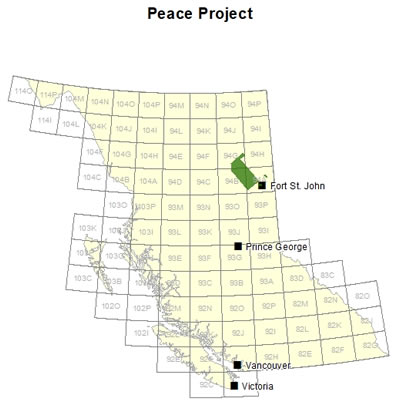New reports deliver “most detailed picture ever” of groundwater in the Peace region

A graphic of the Geoscience BC Peace Project. — Photo courtesy Geoscience BC Two new reports published by Geoscience BC today provide valuable new i
A graphic of the Geoscience BC Peace Project. — Photo courtesy Geoscience BC
Two new reports published by Geoscience BC today provide valuable new information about groundwater resources in northeastern BC’s Peace region.
The reports are part of Geoscience BC’s Peace Project, a three-year multi-disciplinary study providing baseline information about groundwater in the Peace region. This new data and knowledge will enable sound, informed decisions to be made about the use and protection of groundwater in an area where hydraulic fracking for natural gas occurs.
“First Nations, communities, governments, industry and concerned citizens want reliable research to better understand the impacts of oil and gas development on groundwater in the Peace region,” said Geoscience BC Chief Scientific Officer Carlos Salas. “The Geoscience BC Peace Project provides the most detailed hydrological picture of the Peace region ever produced. Groundwater resources in this region can now be assessed more accurately than ever before.”
In the report Processing and inversion of SkyTEM data leading to a hydrogeological interpretation of the Peace River North Western Area, Aarhus Geophysics and Geological Survey of Denmark and Greenland used best practice processing techniques to create two-dimensional slices and three-dimensional models of the northwest corner of the Peace Project area. These results can be used to predict the location of groundwater down to 300m below the surface with more accuracy than ever before.
In the report Peace Project Area – Comparison of resistivity gamma and geological logs with airborne EM inversions, Dr. Mel Best and Dr. Vic Levson compared core samples and geophysical measurements obtained from an eight-well drilling program against geological models generated from the Peace Project’s 2015 airborne survey. Examining the sediments in these wells helps make more accurate predictions in areas where wells and drill logs are not available.
The Geoscience BC Peace Project is acquiring, interpreting, and sharing new baseline scientific information about groundwater resources in the Peace region of northeastern British Columbia.
The following reports are now available through Geoscience BC's website or our Earth Science Viewer.
View project page and Earth Science Viewer.
Report 2018-06 Processing and inversion of SkyTEM data leading to a hydrogeological interpretation of the Peace River North Western Area—By Aarhus Geophysics and GEUS (the Geological Survey of Denmark and Greenland)
In 2017, Aarhus and GEUS processed a portion of the EM dataset in the north-west corner of the Peace Project area, incorporating well log information from previous studies. The main purpose of this work was to create a reliable 3D model of the area and use it to identify structures and sediment units that could potentially host groundwater resources. The Aarhus models identified over 30 layers within the top 300 metres and two generations of paleovalleys, narrowing down the location of these potentially important groundwater host units.
Report 2018-08 Peace Project Area – Comparison of resistivity gamma and geological logs with airborne EM inversions—By Dr. Mel Best Bemex Consulting International & Dr. Vic Levson, Ph.D., P.Geo. Quaternary Geosciences Inc.
In 2017, Best and Levson compared the airborne EM inversions (2016-09) with the new borehole geological logs and the resistivity and gamma logs collected in earlier 2017. In report 2018-08, Best and Levson overlay the drill hole information with the relevant 2D slices through the geophysics to see how well the predictions from the geophysical models match the sediments encountered. These correlations can be used to improve the detail and accuracy of the geological models in areas where wells and drill logs are unavailable.
Geoscience BC is an independent, non-profit organization that generates earth science information in collaboration with First Nations, local communities, governments, academia and the resource sector. Our independent earth science enables informed resource management decisions. Geoscience BC gratefully acknowledges the financial support of the Province of British Columbia.




